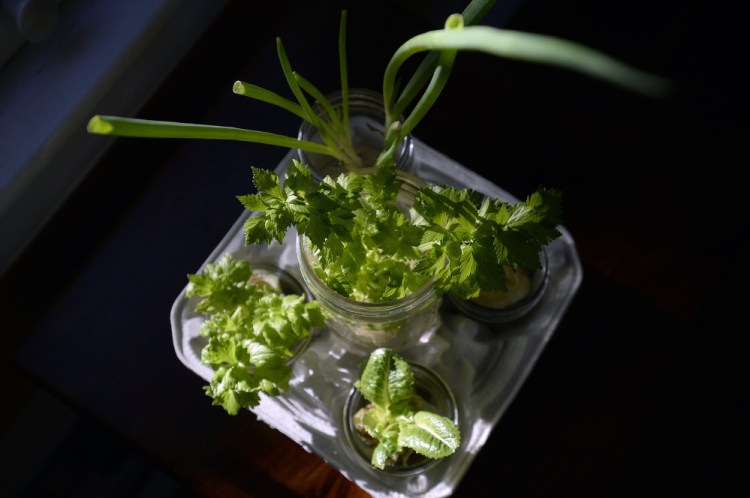I’ve openly admitted in the past that my thumbs are far less green than my eyes. But given my moderate success with last summer’s herb garden, coupled with Press Herald reporter Mary Pols’ recent account of a lovely stroll through a picturesque online collection of old Maine seed catalogs, which piqued my interest and my appetite, I am seriously considering a raised bed of my own in 2016.
I’ve been practicing, actually. On a small table, next to the phone, in a sunny, south-facing kitchen window, not too close but not too far from a baseboard heater, sits a repurposed coffee cup carrier kitted out with several small Mason jars.
In them I am regrowing vegetables I’ve taken home from the market and the produce aisle, sprouting them from their bottom bits – otherwise destined for the stockpot, compost pile or trash can – and plain old Brunswick tap water.
There are scallions, cilantro stems, celery stalks, romaine lettuce heads and fennel bulbs. The scallions regenerate the fastest. The trimmed green stalks keep growing taller and new shoots keep coming out of the white part, whose hairy roots tentacle through the water I refresh every other day.
The cilantro came with its roots, so it continues to grow via them, and since I don’t use a lot of cilantro, it’s kept me in ample supply. I cut the celery, lettuce and fennel down to the still-connected nub and new vegetative life springs up from inside of each vegetable’s inner rings. The celery is more leafy than stalky, the lettuce after three weeks is too darn cute to cut, and the fennel is by far the tortoise is this race.
My tabletop micro-garden is by no means a high-tech hydroponics operation that would hyper-efficiently circulate the perfect amount of nutrient-rich water to commercially produced lettuces, tomatoes, cucumbers, strawberries and green peppers. Setting up something completely in line with the growing field of science whereby flowers, vegetables and herbs are grown in sand, water or air requires more gear, nutrients, power, floor space and patience than I have.
I certainly don’t discourage readers from either building a cheap DIY hydroponics system or tapping local suppliers like High Wire Hydroponics in Raymond or GrowLife Hydroponics in Portland for equipment to pull off a hydroponics home garden.
The green arguments in favor of hydroponics include the fact that fertilizing nutrients intended for the plants are not leached through the soil into groundwater where they can harm habitats downstream. And the fact that hydroponics systems can be set up anywhere could reduce the economic and environmental cost of trucking food into arid places. (It sounds counterintuitive – you’d think something called hydroponics would use a lot of water. Actually, the systems recirculate water, which makes them very efficient.)
The sustainability concerns about hydroponics systems historically relate to infrastructure costs and energy usage, but according to institutions like Cornell University, the University of Florida and Texas A&M, these huge greenhouses and water circulation systems within them are being built more efficiently every year and are increasingly powered by renewable energy sources.
Again, I am not a convert, just curious how watching these vegetables sprout in water in my kitchen might lead to me playing in the dirt in a few months’ time.
Christine Burns Rudalevige is a food writer, a recipe developer and tester, and a cooking teacher in Brunswick. Contact her at cburns1227@gmail.com.
Send questions/comments to the editors.



